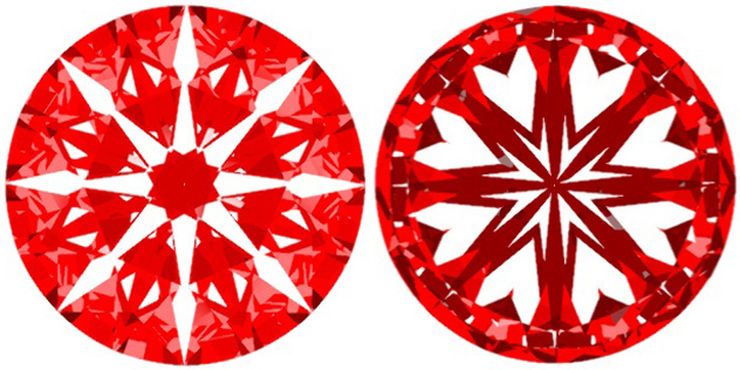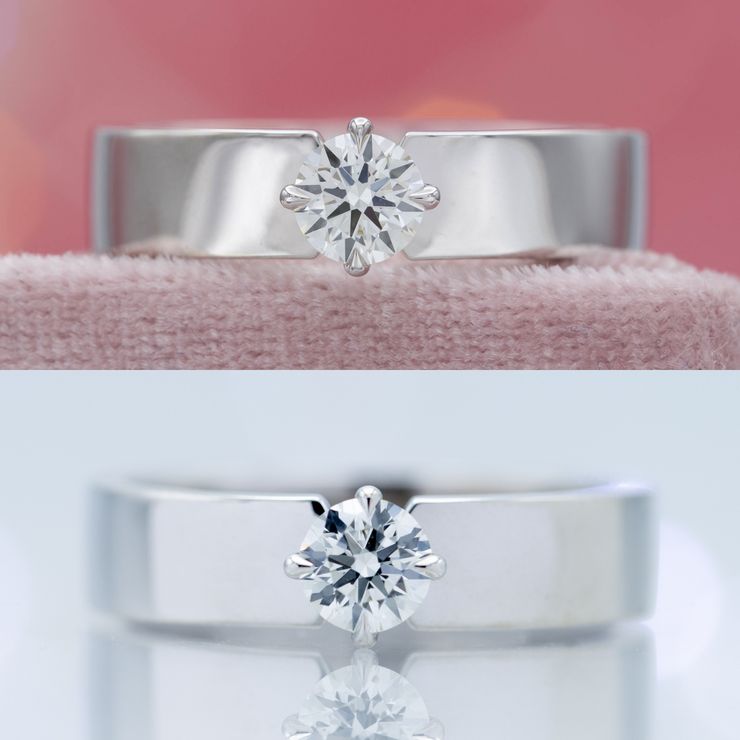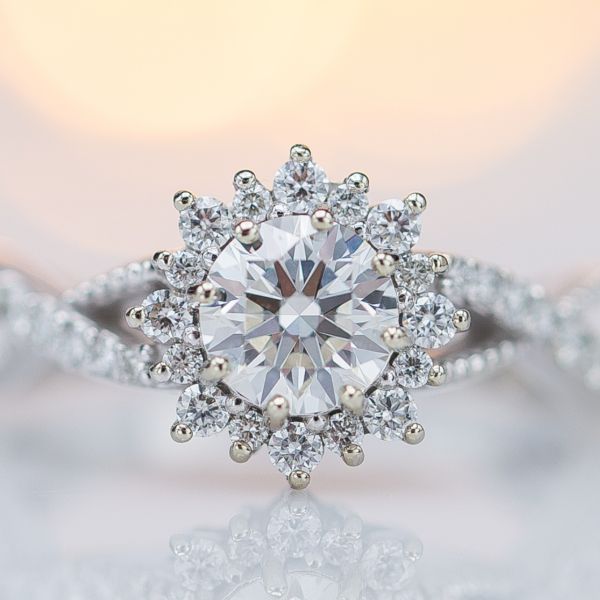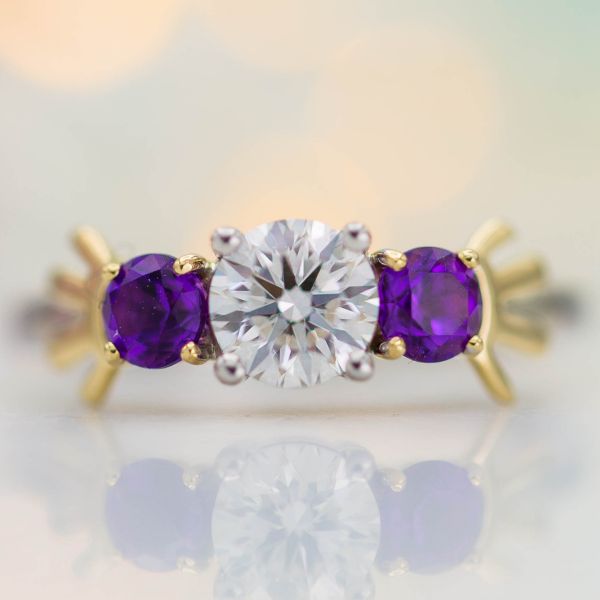Diamond Knowledge
Hearts & Arrows Diamonds
What is a Hearts & Arrows diamond and is it worth the higher price tag?
What are Hearts & Arrows Diamonds?
Hearts & Arrows refers to a specific type of optical symmetry present in highly symmetrical round brilliant cut diamonds. Hearts & Arrows diamonds have surged in popularity during the past several years and are absolutely something we offer. The symmetry has a subtle effect and comes with about a 10-15% price premium. Read on or talk to us to decide if it's right for you.
Whether or not a diamond has Hearts & Arrows is determined by a visual review with the aid of an optical tool like an Ideal-scope or Hearts & Arrows viewer. The "arrows" are visible from a diamond's face up view and represented by the 8 dark areas emanating from the center of the diamond that produce contrast and scintillation. The "hearts" refer to areas that appear white when the diamond is flipped upside down and viewed through the proper tool. They can't be seen with the naked eye, even under magnification.
Reference to "hearts and arrows" first came into use in Japan and was trademarked by Kinsuka Yamashita in 1988. The term's intrinsic appeal and association with Cupid helped it to spread globally to a consumer base that was becoming increasingly focused on cut quality. This was part of the same trend that led GIA to introduce cut grades for round brilliant cut diamonds in the late 1990s. The focus on cut has been a great trend for consumers and means that the average diamond today is meaningfully better cut than the average diamond 40 years ago.
Who certifies that a diamond has Hearts & Arrows?
What level of symmetry qualifies a diamond for a Hearts & Arrows distinction? It depends. Unlike the 4Cs, which are graded by independent labs like GIA, there is no prominent independent lab that rates a diamond's Hearts & Arrows. Typically, the Hearts & Arrows information that exists come from the retailers of the diamonds themselves. The distinctions tend to vary, so we believe the best approach is to present that nuance. For the subset of diamonds that do have this symmetry, we'll let you know if they have good, very good, or excellent hearts and arrows.
One other thing to be aware of is the increasing availability of branded hearts & arrows specialty cuts. Each company designs and markets these differently. Some are simply applying a brand name to excellent cut diamonds that have perfect Hearts & Arrows symmetry. Others have designed gimmicky cuts that reveal the telltale arrows pattern but don't deliver the brilliance of an excellent round brilliant cut. In short, we recommend a bit of caution around branded vendor terminology.
What do you need to know about a Hearts & Arrows diamond?
Will I see the difference?
In short: not with the naked eye. Under magnification (for example, in our photos of your ring), you'll be able to see the arrows. The photos we've included on this page are a perfect example of what you'll see with the help of a zoom lens. You won't be able to see hearts, since they require viewing the stone from underneath with a special tool. But it's important to know that you really won't be able to see this detail with the naked eye. In fact, even trained graders need to use tools like an Ideal-scope to determine if a diamond meets their Hearts & Arrows standard.
To help drive this point home, take a look at these two photos we took of the same diamond. One lines up perfectly head-on to capture the arrows. The other has the slightest angle, immediately losing some of the pattern. Remove the zoom and add sparkle and a moving hand into the equation and your chances of catching the perfect angle are very slim.
Are Hearts & Arrows diamonds better cut?
Not necessarily. A round brilliant cut diamond can have excellent cut characteristics and proportions to ensure maximum sparkle, but not have the specific symmetry required to show the Hearts & Arrows pattern. And in rare cases (especially with non-standard gimmick cuts) a diamond might have Hearts & Arrows symmetry while falling short on other cut characteristics. In other words, if you're most worried about having a perfectly cut diamond, you don't need a Hearts & Arrows diamond, but you can certainly get both!
Sounds like you're saying they're not worth it...
We wouldn't go that far! A very small fraction of diamonds are cut with Hearts & Arrows symmetry, and some find that rarity and uniqueness to be worth the extra cost. There's also something wonderfully romantic about the symbolism that you'll know the diamond carries. And we can usually capture the look in our photos of your ring, so you'll always have those beautiful images to show off as you tell the story of your diamond. For some, that's absolutely worth a little extra cost. For others, it's a silly reason to pay more. We'll absolutely understand if you come out on either side of that decision!
Conclusion
Hearts & Arrows means a more symmetrical diamond with the knowledge that the diamond's cut is particularly rare, and that the symbols of Cupid can be found in its facets. That said, it makes a subtle visual difference that you're unlikely to see with the naked eye. The quality improvement is comparable to going from VS to VVS in clarity or F to D in color. These adjustments improve the quality of the diamond, but in ways that you won't be able to see with your naked eye. So you'll have to decide if you want to devote some of your budget to this distinction, or if you'd prefer to focus on something else, like the size of the diamond.
And we'll stress that the overall cut grade remains by far the most important aspect of a diamond's brilliance and beauty and incorporates everything from proportions to symmetry. Labs like GIA have taken a hard look at Hearts & Arrows and chosen not to incorporate it into their grading. The main reason is that in blind studies, customers aren't able to tell the difference between a Hearts & Arrows diamond and a similarly well-cut diamond without Hearts & Arrows. The proportions incorporated in cut grades like table size and depth have been proven to have a much larger impact on perceived beauty, so that's where GIA directs its focus. And that's where we typically focus, too.
About CustomMade
CustomMade designs and creates one-of-a-kind, custom engagement rings and fine jewelry. Each piece we create is inspired by you, designed for you, and made just for you.



